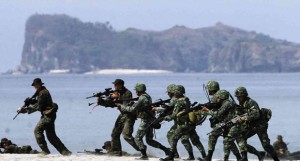MANILA, Philippines—The Philippine Navy’s plans for developing Naval Forces West (Navforwest) and Oyster Bay in Palawan, the bases which are the country’s first line of defense in the West Philippine Sea, have suffered a hitch.

THE VIEW FROM CHINA. US Marines storm a beach along the West Philippine Sea on Friday but only to simulate an amphibious landing during joint US-Philippines military exercises dubbed Balikatan 2014 at San Antonio, Zambales. This year’s war games focus on maritime security. The exercise came even as tensions simmer between the Philippines and China over rival claims to territory in the West Philippine Sea, part of the South China Sea within Manila’s 370-km exclusive economic zone. MARIANNE BERMUDEZ/ INQUIRER FILE PHOTO
Despite the urgent need to improve the bases, the plans for their development cannot proceed because the P500-million budget for them was to be sourced from the Malampaya Fund which the Supreme Court has last year ruled may not be used for other than energy-related projects.
“The ongoing financial issue has caused setbacks to the implementation of the projects as legal issues have to be sorted out diligently by the government,” said defense department spokesperson Peter Galvez.
Under the Navy’s planned work schedule, construction at Oyster Bay should have been in full swing by now and some projects should have been completed by August.
But the only activities that could be seen on a visit to Oyster Bay last week were the construction of a boathouse and the exercise routines of the sailors whose ships were docked there at the time.
The main pier is in obvious need of repair as its wooden planks are rickety.
The development of the Navforwest headquarters and Oyster Bay are in line with the strategic goals of the government on maritime security and territorial defense.
Aside from the improvement of the naval detachments, the plan includes upgrading the Navy’s radar systems that would conduct monitoring activities similar to the government’s Coast Watch System.
Sen. Antonio Trillanes IV, a former naval officer, said in a phone interview he believed that the Malampaya Fund should also be used for “security-related expenditures of the AFP.”
“This will range from the upgrading of the AFP’s capability for bases development … anything concerning or related to providing security to the Malampaya oil rig,” Trillanes said.
He explained that the “energy-related activities” were being protected by the military during its regular patrols of the Malampaya natural gas field, hence, one cannot be separated from the other.
Trillanes said he will file a bill on Monday to amend Presidential Decree No. 910 to expand the coverage of the Malampaya Fund’s uses to include the financing of security-related expenditures of the AFP.
This would include operational support, capability materiel and technology development provided by the AFP “with the end in view of safeguarding the whole Malampaya undertaking,” he said.
President Aquino’s visit to Navforwest headquarters at Ulugan Bay on May 27 for the Navy Day celebrations was viewed as a symbolic gesture by the Commander in Chief whose rhetoric has been quite strong against China in the face of the territorial row between the two countries.
RELATED STORIES
Hagel: China territorial claims destabilize region
SC urged to rule on exploration agreement with China, Vietnam
Chinese fishing in disputed waters threatens PH marine life

